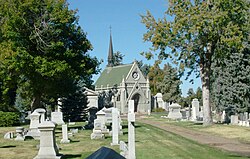| Fairmount Cemetery | |
|---|---|
 A view of Fairmount Cemetery with the Little Ivy Chapel in the background. | |
 | |
| Details | |
| Established | 1890 |
| Location | 430 S Quebec St, Denver, Colorado |
| Country | United States |
| Type | Non denominational |
| Size | 280 acres (110 ha) |
| Website | Fairmount Cemetery |
| Find a Grave | Fairmount Cemetery |
| The Political Graveyard | Fairmount Cemetery |

Fairmount Cemetery in Denver, Colorado, was founded in 1890 and is Denver's second oldest operating cemetery after Riverside Cemetery.[1][2] It is located in land south-east of the intersection of the major Denver roadways Alameda Ave. and Quebec St. (originally called Hyde Park Avenue). The cemetery was designed by German landscape architect Reinhard Schuetze.[3] The cemetery was patterned after Mount Auburn Cemetery in Cambridge and Watertown, Massachusetts. The cemetery occupies 280 acres (110 ha). The first year the cemetery opened over 4500 trees and shrubs were planted by Schuetze.[4] The cemetery is the largest arboretum in the state.
The cemetery contains many fine monuments, including works by Robert Garrison, John Paulding, Arnold Ronnebeck, Pompeo Coppini and others.[5]
The cemetery also contains three structures which have been designated as official historic landmarks by the City of Denver: the Little Ivy Chapel, the Gate Lodge, and the Fairmount Mausoleum. The Little Ivy Chapel and the Gate Lodge were both constructed in 1890, the year the cemetery opened, and were designed by architect Henry Ten Eyck Wendell. The Fairmount Mausoleum, constructed in 1929 and opened in 1930, was designed by architects Frederick E. Mountjoy and Francis W. Frewan.[3]
- ^ Colorado museums and historic sites. University Press of Colorado. 2000. ISBN 0-87081-572-5.
Many of Colorado's leading figures are interred in Fairmount Cemetery, founded in 1890 in southeast Denver, ...
- ^ "Fairmount Cemetery". Denver Rocky Mountain News. October 31, 1999. Archived from the original on October 26, 2012. Retrieved 2009-07-07.
- ^ a b "Fairmount Cemetery". Fairmount Cemetery, Denver. Retrieved 2009-07-07.
- ^ "Fairmount Cemetery". Fairmount Cemetery, Denver. Retrieved 2011-06-06.
- ^ Kvaran, Einar Einarsson Cemetery Sculpture in America, unpublished manuscript
